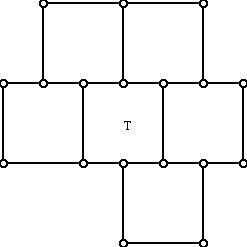
Geometric Stuctures: Session 1 (Comments and Loose Ends)
Prepared by:
Joseph Malkevitch
Department of Mathematics
York College (CUNY)
Jamaica, New York 11451
email:
malkevitch@york.cuny.edu
web page:
http://york.cuny.edu/~malk/
1.
Euclid's Elements, as spectacular as they are as an example of axiomatic deductive mathematics, do not meet modern standards of rigor. First, Euclid wrote as if it was possible to define all the terms in his system. Thus, he gives definitions for "point" and "line." It is partly because he did define all his terms that makes some people wonder if Euclid felt he was describing physical space in the Elements rather than developing a deductive system. A modern views of axiomatics is that one must have undefined terms in a mathematical system and the axioms provide the "relationships" between these terms that one wishes to capture. By using undefined terms one can prove facts in many cases about different objects at once since there may be many different kinds of things, which, when one "interprets" the meaning of the undefined terms, obey the axioms. For example, when one axiomatizes the mathematical concept of a group and does not initially specify what the objects in group are or what is the binary operation one is dealing with, then there are many ways to assign meaning to the objects and the nature of the binary operation. Thus, the integers form a group with respect to the binary operation of addition and the isometries of a (Euclidean) square also form a group. Here, the binary operation is the (function) composition of the different isometries. In the geometric setting, there are often different ways to think of the undefined terms "point" and "line" in concrete terms, and then to check if with these interpretations the axioms are valid. Second, with hindsight we realize that the axioms that Euclid chose were not good enough to recapture the geometry we think of as Euclidean geometry. For example, in the analytical geometry interpretation of Euclidean geometry, if we restrict points to have rational number coordinates and lines (Ax + By + C = ) to having rational number values for A, B, and C, one gets a different geometry from what happens when one uses real numbers for the coordinates of points and the coefficients of the linear equations. However, there are many more surprising and subtle problems in Euclid. It was only with the publication of David Hilbert's work on the foundations of geometry in the early years of the 20th century that it was felt that a complete resolution of the difficulties with Euclid's axiomatization were satisfactorily treated. Even to this day, interesting aspects of axiomatics are still being examined.
2.
Other issues involving language and axiomatics systems arise in regard to the "technical" vocabulary in such systems. Examples of the situation here concern, for example, how to define a term like "polygon" or "trapezoid." In defining such terms one can have a variety of different goals, ranging from using as few words in the definition as possible, to having the term comply with day-to-day language as much as possible, to using a term which encourages a range of mathematical explorations. There is also the issue of avoiding any ambiguity in meaning to make sure that the property one is hoping to capture is achieved. The issue of definitions is quite complex. To get an idea of the issues involved, write down your definition of a triangle and compare it with the definition a friend might give for the same term.
3.
Terminology involving polygons and polyhedra have proved to be particularly challenging. In retrospect, lots of new mathematics has grown out of attempts to generalize to broader contexts important terms that initially were used with much more narrow meanings. Thus, Euclid never mentions the concept of convexity in the Elements, and while the pentagram was a shape known in the ancient Greek world, it was not thought of as a regular polygon at that time.
4.
It is often challenging to work with similar ideas but in different contexts. For example, if one is handed an infinite collection of square linoleum tiles, one can see how to tile the plane with these squares where each square abuts completely along another edge of a square. However, if one takes a completed tiling of the plane in this manner and slides one row of the square tiles, one gets "regions" which, when one counts the number of vertices of these regions, have 6 vertices. Thus, as tiles we have 4-sided objects, but as regions in the tiling, such as the one labeled T in the diagram below, we have "hexagons." This kind of tension between different ways of looking at mathematical structures is one source of new ideas and problems in mathematics.

The word polyomino was coined by Solomon Golomb to discuss a special way of assembling squares, specifically, 1x1 squares where the squares meet edge to edge, and lie in a plane. The nets of a cube are examples of special hexominoes. Golomb had to decide whether or not to allow "holes" in a polyomino. For some purposes "holes" are allowed, for others it turns out to be "convenient" not to allow them.
This discussion allows us to see the ways in which definitions of mathematical terms have certain analogies with "conventions" in the real world. Thus, in America we drive on the right side of the road while in England people drive on the left. In relatively modern times, Sweden, where people had driven on the left decided on a specific day to change to the right. In the 19th century the gauge of track in countries which shared a border were different. Eventually, it became clear that there were great advantages in having the train tracks in France, Belgium, and German all be the same!